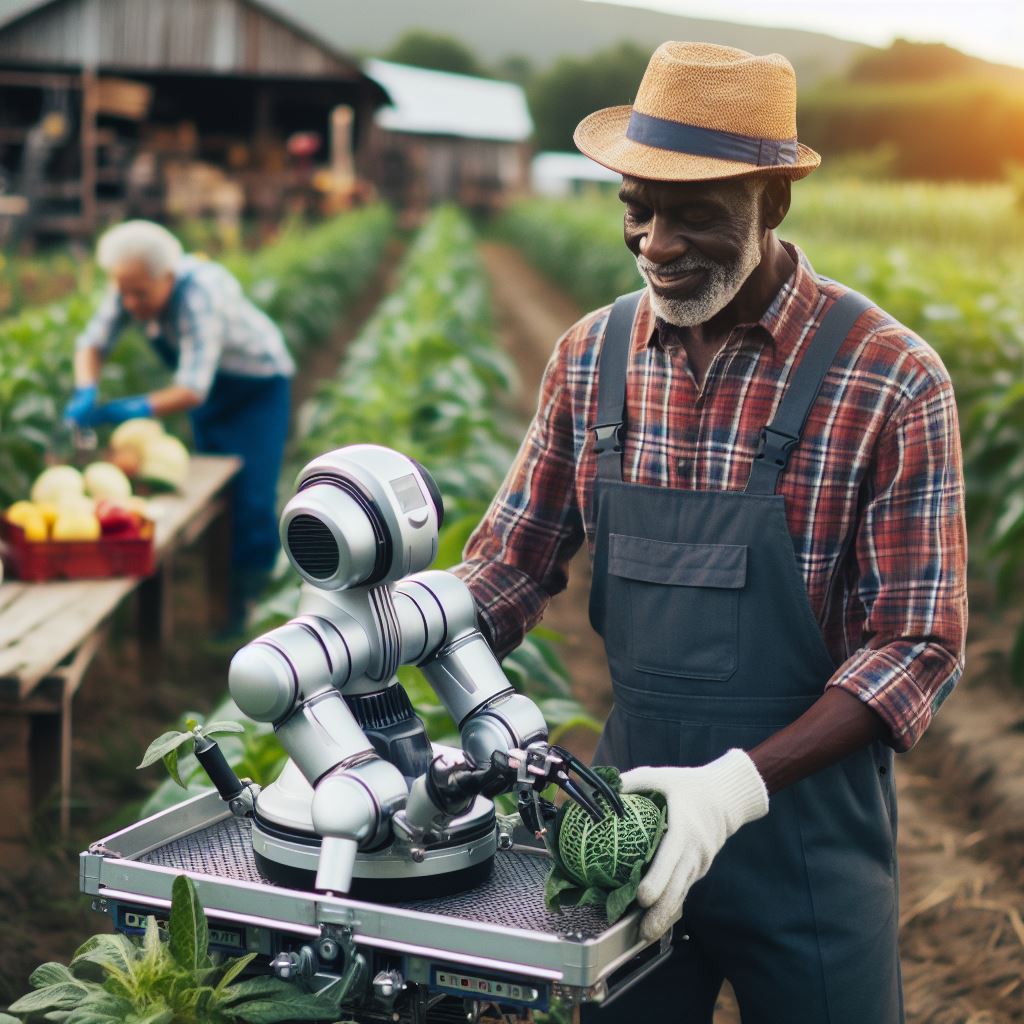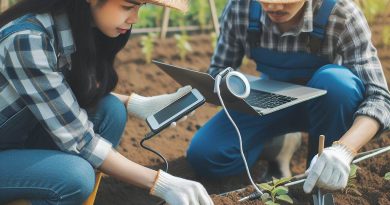Robotics in Farming: A 2024 Guide
Last Updated on January 19, 2024
Introduction
In recent years, robotics has become a game-changer in the field of agriculture.
Robotic technology provides numerous benefits to farmers and revolutionizes the way they work.
One of the key advantages of using robotics in farming is the increased efficiency and productivity.
Robots can perform repetitive tasks at a faster pace and with a higher level of accuracy compared to humans.
By automating these tasks, agricultural processes can be streamlined, saving both time and resources.
Furthermore, the implementation of robotics in farming can lead to a significant reduction in labor costs.
With robots taking over manual labor, farmers can allocate their resources more effectively and reduce dependence on human workers.
This not only lowers operational costs but also eliminates the need for seasonal workers, reducing financial constraints.
Precision and accuracy are also greatly enhanced by integrating robotics into agriculture.
Robots equipped with advanced sensors and imaging technology can efficiently detect and respond to changes in the environment.
They can precisely apply fertilizers and pesticides, improving crop yield while minimizing the use of chemicals.
Basically, robotics has become increasingly important in agriculture, offering enhanced efficiency and productivity, reduced labor costs, and improved precision.
Overview of current state of robotics in farming
In the agricultural industry, robotics has become an increasingly important and innovative tool. Current state of robotics in farming:
Types of robots used in agriculture
- Harvesting robots: These robots are capable of autonomously picking fruits and vegetables, increasing efficiency and reducing labor costs.
- Weed control robots: These robots use advanced imaging systems to identify and remove weeds, reducing the need for chemicals.
- Monitoring and data collection robots: These robots collect data on soil conditions, crop growth, and weather patterns, providing valuable insights for farmers.
Benefits and limitations of using robotics in farming
- Increased crop yield: Robots can optimize planting and harvesting techniques, resulting in higher crop productivity.
- Reduction in chemical usage: With weed control robots, farmers can minimize the use of harmful herbicides and pesticides.
- Initial investment and maintenance costs: Implementing robotics in farming requires a significant upfront investment and ongoing maintenance expenses.
- Need for skilled operators: Operating and maintaining agricultural robots often requires specialized training and expertise.
Despite the initial challenges, the potential benefits of using robotics in farming are substantial.
By leveraging this technology, farmers can not only improve their efficiency and productivity, but also contribute to sustainable agricultural practices.
Types of robots used in agriculture
Harvesting robots
Harvesting robots, for example, have the ability to pick fruits and vegetables at a much faster pace than human workers.
This allows farmers to harvest their crops quickly and efficiently, reducing the risk of spoilage and maximizing yields.
Additionally, these robots can work day and night, further increasing productivity.
Weed control robots
Weed control robots are another valuable tool in the agricultural industry.
Traditionally, farmers have relied on herbicides to control weeds, which can be harmful to both the environment and human health.
With the advent of weed control robots, farmers can now target specific weeds with precision, minimizing the need for chemical usage.
Monitoring and data collection robots
Monitoring and data collection robots provide farmers with detailed information about their crops.
These robots can collect data on soil moisture, nutrient levels, and pest infestations, allowing farmers to make informed decisions about irrigation, fertilization, and pest control.
By optimizing these factors, farmers can maximize crop growth and minimize resource waste.
Challenges that needs to be addressed
While there are notable benefits to using robotics in farming, there are also challenges that need to be addressed.
The initial investment and maintenance costs associated with these technologies can be prohibitive for many farmers, especially those with limited financial resources.
Furthermore, the successful operation of agricultural robots often requires skilled operators.
These individuals must have a deep understanding of both agriculture and robotics, ensuring that the robots are utilized to their full potential.
Additionally, ongoing training and education are necessary to keep up with the latest advancements in this rapidly evolving field.
In essence, the current state of robotics in farming is rapidly advancing.
From harvesting and weed control robots to monitoring and data collection robots, the potential benefits for the agricultural industry are vast.
Although there are challenges to overcome, the integration of robotics in farming has the power to revolutionize the way we cultivate crops, leading to increased productivity, reduced environmental impact, and improved sustainability.
Read: Climate Smart Agri: Tools & Techniques
Latest advancements in agricultural robotics
Integration of artificial intelligence and machine learning
With the continuous advancement of technology, agricultural robotics has made significant progress in recent years.
The integration of artificial intelligence and machine learning has revolutionized farming practices.
Farm robots now have enhanced decision-making capabilities, leading to improved productivity and efficiency.
Improved autonomous navigation allows robots to navigate through fields accurately and efficiently.
Development of multi-purpose robots has increased their versatility in performing various farming tasks.
These robots can now plow, plant seeds, monitor crops, and even pick fruits and vegetables.
Cost-effectiveness is another notable development in agricultural robotics, making it accessible to a wider range of farmers.
Collaboration between robotics and other technologies
One of the most exciting collaborations is the use of drones for crop monitoring and spraying.
By employing drones, farmers can obtain real-time aerial images of their fields, allowing them to monitor crop health.
Drones equipped with spraying capabilities enable targeted and precise application of fertilizers and pesticides.
Another technology that has revolutionized agriculture is the Internet of Things (IoT).
IoT devices provide real-time data analysis, allowing farmers to make informed decisions for optimal crop management.
With the integration of robotics and IoT, farmers can harness the power of data analytics to improve agricultural practices.
As we look towards the future of farming, agricultural robotics continues to evolve and play a crucial role.
The integration of artificial intelligence and machine learning has made robots smarter and more efficient in performing various tasks.
Improved autonomous navigation ensures accurate and precise operations in the fields.
Furthermore, the development of multi-purpose robots offers versatility in addressing different farming needs.
Collaboration with other technologies such as drones and IoT brings real-time data analysis and monitoring capabilities to farmers.
With the continued advancements in agricultural robotics, farmers can expect increased productivity, efficiency, and sustainability in their operations.
Read: Efficient Watering with IoT in Agri
Potential applications of robotics in farming by 2024
Robotics in farming is expected to revolutionize the agricultural industry by 2024, with potential applications that can significantly improve efficiency and productivity.
Let’s explore some of the key areas where robotics can make a difference:
Automation of Sensitive Tasks
- Planting and seeding can be automated using robots, ensuring precise placement and reducing human error.
- Harvesting and sorting of crops can be efficiently carried out by robots, saving time and labor.
- Pruning and damage assessment can be automated, allowing for early detection and prevention of plant diseases.
Environmental Monitoring and Control
- Robots can perform soil analysis and nutrient management, providing real-time data for optimal fertilization.
- Pest and disease detection can be done using AI-powered robots equipped with advanced sensors, minimizing crop losses.
- Irrigation and water management can be automated, ensuring optimal water usage while conserving this valuable resource.
These are just a few examples of how robotics can transform farming practices and address the challenges faced by the agricultural sector.
By automating sensitive tasks and monitoring environmental conditions, farmers can optimize their operations and achieve higher yields.
Advantages of using robots
One of the main advantages of using robots in farming is their ability to work tirelessly and consistently, without being affected by fatigue or external conditions like temperature or weather.
This reliability can have a significant impact on productivity.
Moreover, the use of robotics in farming can also lead to more sustainable practices.
By analyzing soil conditions and nutrient levels, farmers can apply fertilizers and other inputs more precisely, minimizing waste and reducing environmental impact.
Similarly, the early detection of pests and diseases can help farmers implement targeted control measures, minimizing the need for harmful pesticides.
The automation of labor-intensive tasks like planting, harvesting, and sorting can also help address the challenges of labor shortages in agriculture.
By reducing the need for manual labor, robots can fill the gaps and ensure that crops are properly tended to and harvested at the right time, maximizing yields.
Challenges with utilizing robotics
However, the widespread adoption of robotics in farming does come with its own set of challenges.
Cost is one major factor that needs to be considered, as robotics technology can be expensive to implement.
Additionally, there may be resistance from traditional farmers who are reluctant to embrace new technologies.
Despite these challenges, the potential benefits of robotics in farming by 2024 are undeniable.
Increased efficiency, higher productivity, and more sustainable practices can all be achieved through the application of robotics in various aspects of farming.
The agricultural industry stands to gain significantly from the advancements in this field, ensuring a more secure and food-secure future.
Read: Solar-Powered Irrigation: A Deep Dive

Impacts and challenges of widespread adoption of robotics in agriculture
Social and economic impacts
- Increased efficiency and productivity due to automation.
- Reduced labor costs as robots perform tasks previously done by humans.
- Improved living standards as agricultural output expands and food prices stabilize.
- Creation of new job opportunities in designing, manufacturing, and maintaining robotic systems.
Job displacement and creation
- Potential loss of jobs for farm laborers as robots replace manual labor.
- Need for retraining and reskilling of workers to adapt to new roles in the agricultural industry.
- New job opportunities in robotic system maintenance, data analysis, and programming.
- Shift from low-skilled to high-skilled agricultural workforce.
Changes in farming practices
- Precision farming enabled through robotics, resulting in reduced resource wastage.
- Improved crop and livestock management through real-time monitoring and data analysis.
- Optimized use of pesticides, fertilizers, and water, leading to environmental benefits.
- Integration of automation with other emerging technologies like AI and IoT.
Regulatory and ethical considerations
- Ensuring the safety and security of robotic systems to prevent accidents and malfunctions.
- Implementation of regulations and standards for the use of agricultural robots.
- Addressing concerns regarding the ethical treatment of animals in automated farming operations.
- Developing guidelines for responsible data collection, usage, and storage.
Safety and security of robotic systems
- Implementing robust safety protocols to prevent harm to humans and animals.
- Protection against potential cyber attacks on agricultural robotic systems.
- Regular maintenance and testing of robots to ensure their proper functioning.
- Continuous monitoring of robotic operations to identify and mitigate potential risks.
Privacy concerns in data collection
- Ensuring data privacy and protection of farmers’ and consumers’ personal information.
- Establishing transparent data governance practices to gain trust from stakeholders.
- Obtaining informed consent from farmers and consumers regarding data collection and usage.
- Anonymizing and aggregating data to maintain individual privacy while enabling data analysis.
In a nutshell, the widespread adoption of robotics in agriculture brings numerous benefits but also presents challenges.
The social and economic impacts include increased efficiency, reduced labor costs, and job creation.
However, job displacement and the need for reskilling must be addressed.
Changes in farming practices result in precision farming and environmental benefits.
Regulatory and ethical considerations involve safety, security, and responsible data usage.
Privacy concerns in data collection call for transparent practices and safeguarding personal information.
Overall, navigating these impacts and challenges is crucial for the successful integration of robotics in farming.
Read: Agri Robots: The Future of Farming Now
Conclusion
Recapping the potential benefits of robotics in farming, it is clear that this technology holds immense promise.
Increased efficiency, reduced labor costs, and optimized crop productivity are just a few advantages that robots bring to agriculture.
However, it is important to emphasize the necessity for continuous research and development in this field.
As technology evolves, so should our understanding and implementation of robotics in farming.
Looking forward, there is great optimism for the future of robotics in agriculture.
With further advancements and refinement, robots have the potential to revolutionize farming practices, making them more sustainable and productive than ever before.


